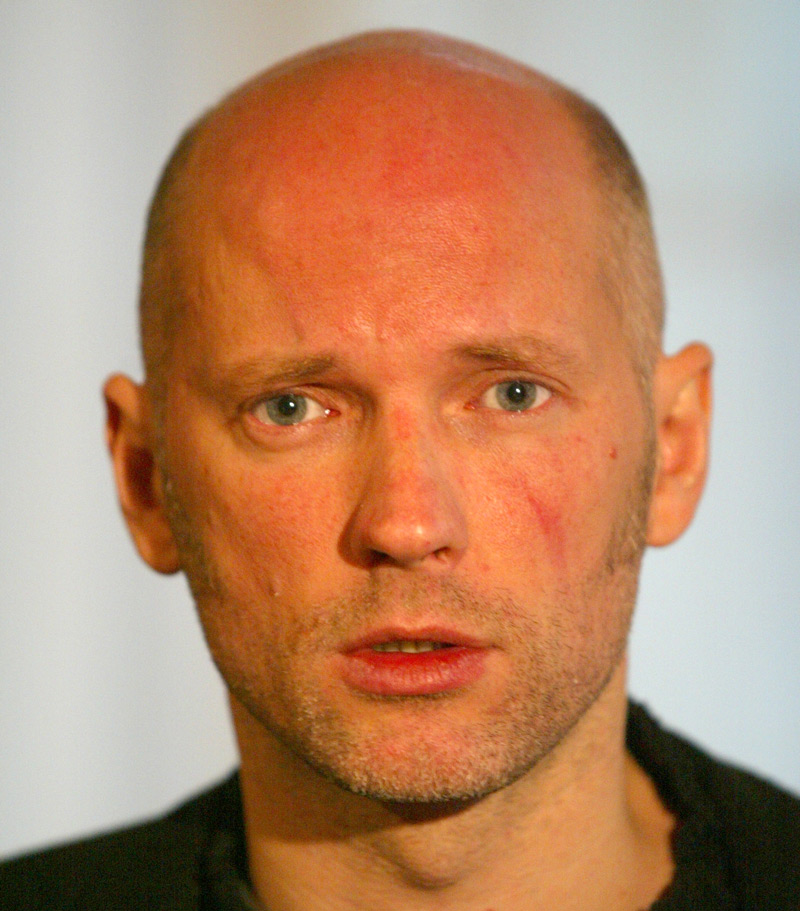about the production
In the productions of this year’s Divadelná Nitra we can meet two types of heroes – famous historical characters such as Penthesilea or Richard III who personify great stories and themes, or characters of ordinary people such as barber Woyzeck or Sonja in the production of the same name by Alvis Hermanis. When we look at the work of this Latvian director, we often do not know whether to laugh or cry. He is renowned for his original view throughout Europe, and in recent period he has been directing also outside his home New Theatre in Riga, mainly in theatres in German speaking countries.
What does Hermanis theatre make so fascinating? It may be the characters of his productions, who are ordinary people and their stories are those from every-day life, and also that Hermanis, with the admirable sense of accurate detail, finds the something hiding under perhaps a banal surface, something which is dramatic, essential, which is common to all of us. Hermanis brings humanity back to the theatre. It is a humanity in sense of understanding and sympathy, in contrast to theatre of estrangement and matter-of-factness, so widespread these days. But his view is not the one through rose-coloured glasses, as we may think. Hermanis can be equally cruel and merciless like the “coolest” artist. The spectrum of emotions, which he raises by his works, is considerably wide and at the same time, he manages to generate those most contradictory.
Basis for Hermanis works is also documentary material. Latvian Stories for instance, is documentary drama where real stories of common people – a taxi driver, bus driver, stripper… become dramatic material. Hermanis´s sense of document, of realism or hyperrealism, is typical for his staging of literary and dramatic works.
Sonja is a novelette by Russian writer Tatiana Tolstaya, the granddaughter of the classic of Soviet literature, Alexei Tolstoy. Hermanis managed to transform to theatrical language the thought which Viktor Yerofeyev, characterising Tolstaya´s way of writing, named like this: “In her short stories there is strong male energy of traditional writing present, which ironically contrasts with a description of unfortunate unimportant faiths. (The author) is willing to caress and support her unlucky heroes, but she is aware of the fact that it is difficult or rather impossible to help them or rescue them. The winners are those cunning, bad, suspicious; the winners are predators, which does not mean that predators are right, simply, there is no logic or justice in life, but there is some pulsing, dreams. Unfortunately, there is nothing to do about it…”
Such is the production of Sonja where we see the world full of pulsing dreams, which sharply contrast with reality, but it is exactly dreams that make the life colourful, though sadder in reality. To avoid a high-flown effect (the high-flown is today understood more pejoratively), the story about lonely Sonja who becomes a victim of a humorous but cruel joke, is told by means of parody. Although Hermanis´s theatrical language seems as hyperrealistic (e.g. stage interiors are furnished in detail), in this play he uses means of parody, irony and citation of theatrical tradition by which the realistic becomes an intensified theatricality and autonomous world of art. The stage space, for instance, is citation of the spyhole-like stage, the “fourth wall” theatre, the acting is based on detailed gestures taken from reality, only the main hero of the story, Sonja, is played by a man… Even if Hermanis´s theatre rouses emotions and sympathy in the audience, it is only at such level that is allowed by grotesque and tragicomic dramaturgy of his productions. And trough this parodying view, which is a mixture of mockery and understanding, we, once again, remember the loneliness, fear of old age and death, longing for love and fulfilment of dreams. And the “non-high-flown” and human message of Sonja could stand as: our happiness rests in ourselves.
Martina Vannayová
creators
directed by Alvis Hermanis
set and costume design: Kristīne Jurjāne
sound: Andris Jarāns
light: Krišjānis Strazdīts
stage manager: Linda Zaharova
actors: Gundars Āboliņš, Jevgeņijs Isajevs
director

Alvis Hermanis (1965)
After graduating from acting at Latvian State Conservatoire he shot few films, later he came back to theatre as director. In his productions, of which he is a director, author, stage designer and in which he also acts, Hermanis plays with different concepts, signs, pictures and symbols of eastern and western cultures. Already his first theatre direction – Like a Calm and Peaceful River is the Homecoming - brought him the Prize for the best production of the season (1992/1993) awarded by Latvian critics. Since then his works have been awarded many prizes and nominations almost every year in Latvia and abroad. The nominated productions were mainly: Marquis de Sade, Seagull, Virgins from Wilka, The Inspector General (Young Directors Project Award – Salzburger Festspiele; Press´Award at the International Festival The Baltic House – St. Petersburg), The Story of Kaspar Hauzer, Latvian Stories, A Long Life (Grand PRIX, International Theatre Festival BITEF´39; International Theatre Festival MESS´45).
Productions by Alvis Hermanis have been successfully presented at international festivals in Lithuania, Estonia, Poland, Russia, the U.S., Canada, Austria, Germany, Slovenia, Finland, France and Belgium. In 2003 he introduced his The Inspector General at Divadelná Nitra. From 1997 he has worked as artistic director in the National Theatre in Riga.
Materials available
Script of the production: SK, EN
If you are interested in these materials, write to archivy@nitrafest.sk
